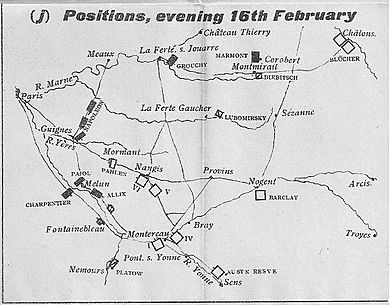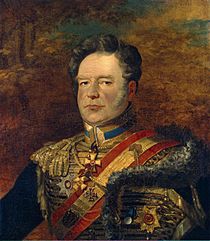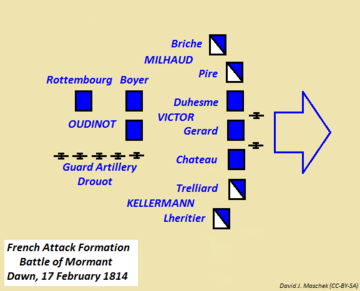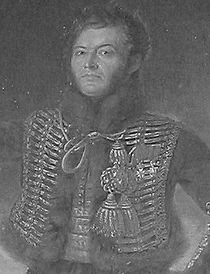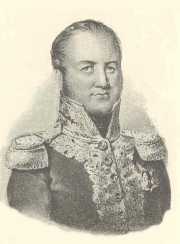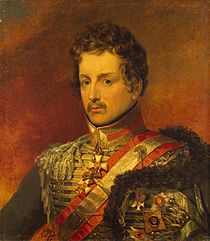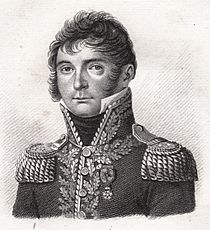Battle of Mormant facts for kids
Quick facts for kids Battle of Mormant |
|||||||
|---|---|---|---|---|---|---|---|
| Part of the Campaign of France of the Sixth Coalition | |||||||
 Battle of Mormant by Jean-Antoine-Siméon Fort |
|||||||
|
|||||||
| Belligerents | |||||||
| Commanders and leaders | |||||||
| Units involved | |||||||
| Strength | |||||||
| 18,000–20,000 | Total: 9,000 |
||||||
| Casualties and losses | |||||||
|
600 800 |
Total: 3,114 |
||||||
The Battle of Mormant happened on February 17, 1814, during the War of the Sixth Coalition. This battle was fought between the French army, led by Emperor Napoleon I, and a group of Russian soldiers. The fight took place near the town of Mormant, which is about 50 kilometers (31 miles) southeast of Paris.
In this battle, the Russian forces were greatly outnumbered. They were surrounded by French cavalry (soldiers on horseback) and infantry (soldiers on foot). Most of the Russian soldiers were captured or killed, with only about a third managing to escape.
Later that same day, another fight happened nearby, called the Battle of Valjouan. Here, a French group attacked an Austrian and Bavarian rearguard (a group protecting the main army's retreat). The Allied forces were badly beaten before they pulled back behind the Seine River. These battles at Mormant and Valjouan, along with the Battle of Montereau the next day, marked the start of a strong French counterattack. Napoleon wanted to push back the Allied army led by Karl Philipp, Prince of Schwarzenberg.
Contents
Background to the Battle
After winning a battle against Napoleon at Battle of La Rothière on February 1, 1814, the Allied generals felt very confident. They made a plan for their main army, led by Austrian Field Marshal Schwarzenberg, to march towards Paris through Troyes. At the same time, Prussian Field Marshal Gebhard Leberecht von Blücher's army would take a northern route towards Meaux.
Napoleon realized that Blücher's army was a bigger threat. So, on February 6, he started moving his troops north to deal with Blücher. He left Marshals Victor and Nicolas Oudinot with 34,000 men to hold off Schwarzenberg's much larger army. Napoleon then headed north on February 9 with 30,000 soldiers.
Napoleon's Victories
Napoleon then won several important battles against Blücher's army in what is known as the Six Days' Campaign.
- On February 10, at the Battle of Champaubert, the French army attacked a Russian group of only 4,000 soldiers. Only 1,700 Russians escaped, and their commander was captured.
- The next day, Napoleon defeated Russian and Prussian forces at the Battle of Montmirail. The French lost 2,000 men but caused 3,700 losses for the Allies.
- On February 12, the French won again at the Battle of Château-Thierry. The French lost 600 men, while the Allies lost 2,750.
- Blücher attacked the French on February 14 but was almost completely defeated at the Battle of Vauchamps. The French lost 600 men, but the Allies lost 6,000.
Overall, Blücher's army of 56,000 soldiers lost over 16,000 men and 47 cannons during that week. Napoleon's army, however, lost only about 4,000 soldiers.
Allied Advance and French Response
While Napoleon was busy fighting Blücher, Schwarzenberg's main Allied army pushed back the French forces led by Marshals Victor and Oudinot. The Allied army advanced closer and closer to Paris. This made the French marshals ask Napoleon for help.
Napoleon quickly moved his troops south to face Schwarzenberg's army. He arrived at Guignes on the evening of February 16. He found Victor and Oudinot's army ready to attack. Napoleon planned to start his offensive the very next day.
The Battle of Mormant
Schwarzenberg's main army had over 100,000 soldiers. However, his forces were spread out. One of his commanders, Wittgenstein, pushed his Russian corps too far west, beyond Provins, towards Nangis. His advanced group, led by Count Peter Petrovich Pahlen, reached Mormant.
Pahlen soon realized that a huge French army was nearby. He had about 2,000 to 2,500 foot soldiers and 1,500 to 1,800 cavalry. He placed two battalions in Mormant and gathered the rest of his troops on both sides of the main road. He was ready to fight or retreat.
Pahlen's Retreat and French Attack
During the night, Pahlen received orders to pull back, but it was too late. At dawn, Pahlen saw the massive French force and began to retreat.
At 5:00 a.m., the French infantry began to advance. French cavalry, led by generals like Édouard Jean Baptiste Milhaud and François Étienne de Kellermann, moved forward on the sides.
Pahlen ordered his two battalions in Mormant to hold back the French for as long as possible. This was to allow the rest of his troops to escape. French cavalry quickly attacked the Russian skirmishers (soldiers fighting in loose formation). General Étienne Maurice Gérard's infantry pushed into Mormant village, forcing the Russian defenders out into the open. French dragoons (cavalry) charged, making many Russians surrender.
On the right side, French cavalry quickly scattered the Cossack regiments (Russian cavalry). As the French chased the fleeing Cossacks, other dragoons charged and broke a Russian square formation (a defensive formation used by infantry against cavalry).
On the north side, Russian cavalry, led by Theodor von Rüdiger, tried to hold their ground. But repeated charges by French cavalry broke their lines and chased them off the battlefield. Without cavalry to support them, Pahlen's infantry battalions had to form squares to defend themselves. French artillery, with 36 cannons, moved to the front and fired heavily on the Russian squares.
Pahlen sent messages asking for help, but the Austrian commander, Anton Leonhard von Hardegg, refused to help and ordered his own troops to retreat. However, two Austrian cavalry regiments were caught by the fleeing Cossacks and then scattered by French cavalry. The Russian infantry continued to retreat, losing many men to artillery fire. They were finally stopped by French cavalry blocking their escape route. Surrounded and under heavy fire, the Russian battalions were completely overrun by cavalry charges.
The Russians lost about a third of their cavalry and over 2,100 foot soldiers. The French captured 9 to 12 cannons. The French cavalry reported losing only 150 horsemen, and Gérard's infantry lost only 30 men. The remaining Russian soldiers scattered across the countryside.
The Battle of Valjouan
After the victory at Mormant, Napoleon divided his army into three groups. Victor led the right group south towards Montereau. Oudinot's group followed the retreating Russians east towards Provins. MacDonald's group headed southeast towards Donnemarie. Napoleon kept his Imperial Guard in reserve.
Victor's group left Nangis at 1:30 p.m. and met enemy resistance around 3:00 p.m. at Villeneuve-le-Comte. Peter de Lamotte, leading the 3rd Bavarian Division, had set up his troops on the Valjouan heights to block the road. His cavalry protected both sides. The Austrian divisions behind him were already retreating.
General Gérard, whose troops were at the front of the French column, decided to attack right away. His brigade stormed Villeneuve and Grand-Maison farm at 3:30 p.m. As the Bavarian foot soldiers ran from their positions, they were attacked by French cavalry. When some Allied cavalry tried to save the Bavarians, the French horsemen charged and chased them away. French cavalry, even newly recruited ones, caused about 300 casualties to their enemies.
Peter de Lamotte formed his division into a square and began to retreat. During this retreat, two Austrian cavalry regiments were attacked by a large French cavalry force and lost 200 men. After marching about 2 kilometers (1.2 miles), Gérard's infantry burst out of the woods and almost broke Lamotte's division. However, the French cavalry was not there at that moment, allowing the Bavarians to regroup and continue their retreat. That evening, the V Corps crossed the Seine River at Bray.
Result of the Battles
The Allied armies had spread themselves out too much, and Napoleon used this chance to strike hard. Historians estimate that the French lost about 600 to 800 soldiers in these battles. The Allies, however, lost around 3,000 to 3,114 men and 9 to 14 cannons. The French army had about 18,000 to 20,000 soldiers in these battles.
Napoleon was upset with Victor for not pushing forward quickly enough. He expected Victor to be at Montereau by 6:00 a.m. the next day. When Victor didn't arrive until 9:00 a.m., Napoleon replaced him with General Gérard. The Battle of Montereau was fought the next day, February 18.
|


